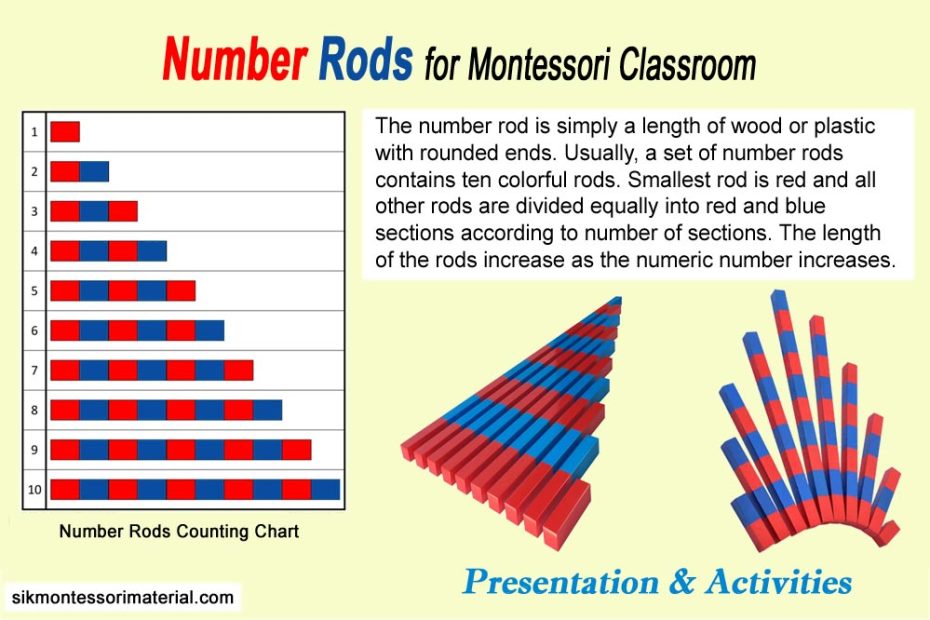In the Montessori classroom, you’ll find a wide array of materials designed to help young learners grasp mathematical concepts in a fun and engaging way. The number rods /number rods expose students to the concept of counting and measurement. These colorful rods, often made of wood, are a valuable resource for teaching children how to count from one to ten. These number rods are introduced to young learners at the age of four years, once the student has mastered the red rods. In this article, we’ll explore the basic aim of this activity, the objectives of the activity, the benefits of using number rods, and how to present number rods them effectively to young learners.
Size and Color of Number Rods
The number rod is simply a length of wood or plastic with rounded ends. Usually, a set of number rods contains ten colorful rods. Smallest rod is red and all other rods are divided equally into red and blue sections according to number of sections. The length of the rods increases as the numeric number increases.
Basic Aim of the Activity
The primary aim of using number rods in a Montessori classroom is to introduce children to the concept of numbers and counting. These rods serve as a hands-on tool to help children associate the visual representation of numbers with their actual quantity. By manipulating these rods, students can develop a strong foundation in mathematics, preparing them for more advanced mathematical concepts in the future.
Significance of Colors and Sensorial Importance
Number rods come in a set of ten, and each rod has a distinct color. The colors serve as a sensorial aid to help children distinguish between the different numbers. The color progression, from red to blue, is a visual representation of the increasing number value. This color coding assists children in grasping the concept of ascending number order, making learning more accessible and enjoyable.
The sensorial aspect of the rods is crucial in Montessori education. Through touch and manipulation, children develop their tactile and visual senses. The rods are not only a visual aid but also an opportunity for children to physically engage with the concept of counting. This hands-on experience helps solidify their understanding of numbers.
Objectives of the Activity
- Number Recognition: Number rods help children recognize and associate numbers with their physical representation.
- Counting Skills: The number rod activity is good for students to practice counting. Children learn to count from one to ten by matching the rods with the corresponding number.
- Order and Sequence: They develop an understanding of the number order from one to ten, setting the foundation for more complex math concepts.
Benefits of Number Rods Activity
Using number rods in the Montessori classroom offers several benefits:
The number rods in the Montessori materials set are a child’s first introduction to mathematical concepts. It provides them with a basic concepts of mathematical principles
Thus, the different activities of number rods allow young learners to understand numbers in terms of quantity. The main benefits of number rod activities are briefly discussed below.
- Hands-On Learning: Children learn by doing. The rods provide a tangible way to explore and understand numbers.
- Visual and Tactile Stimulation: The combination of colors and tactile experiences helps engage multiple senses, making learning more enjoyable. It allows young learners to visualize how numbers can be manipulated in different ways and how numbers relate to one another.
- Independence: Montessori materials are designed to encourage independent learning. Number rods empower children to explore and learn at their own pace.
- Preparation for Mathematics: This activity lays the groundwork for more advanced mathematical concepts, making the transition to arithmetic and other math activities smoother.
How to Make a Good Presentation for Learning
Presenting number rods effectively in a Montessori classroom is essential to engage students and promote learning. Here are some steps to ensure a successful presentation:
- Prepare the Environment: Ensure that the classroom is organized and free from distractions. There is a sufficient light in the classroom.
- Use Clear Language: Use simple, age-appropriate language to explain the activity to the children. Repeat the words many time that you want to make learned by students.
- Demonstrate: Always begin by demonstrating the use of the number rods, emphasizing the colors and numbers. Repeat the numbers again and again and speak out color names when presenting rods to learners.
- Hands-On Exploration: After the demonstration, allow students to handle the rods, count them, and match them to the corresponding numerals. Help the in counting the rods and repeat with the learners. Whisper slowly to provide the hints when you have repeated many times.
- Encourage Exploration: Give children the freedom to explore the rods independently. Engage all the learners equally in the activity. Be available to offer guidance and support as needed.
- Using Montessori Material: Be aware of the learners’ activities and ensure proper use of number rods. Do not let the learners to place rods vertically if they are big in size. Because dropping of the rod may cause injury to the young learners.
- Repetition: Reinforce the activity regularly, allowing students to revisit and practice with the rods.
Conclusion
Number rods are a valuable tool in the Montessori classroom for introducing children to the world of numbers. The colors, tactile experience, and hands-on approach make learning fun and effective. By presenting number rods with clear language and allowing for independent exploration, teachers can help students build a strong foundation in mathematics, setting them on the path to mathematical success.

